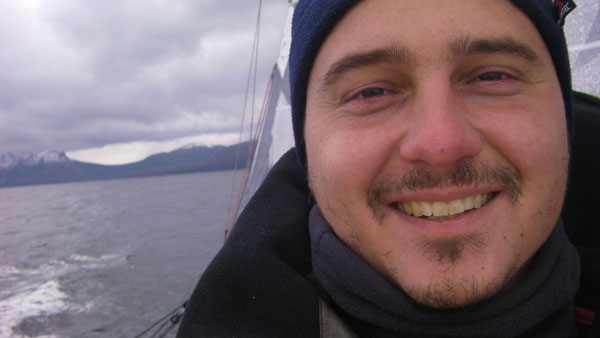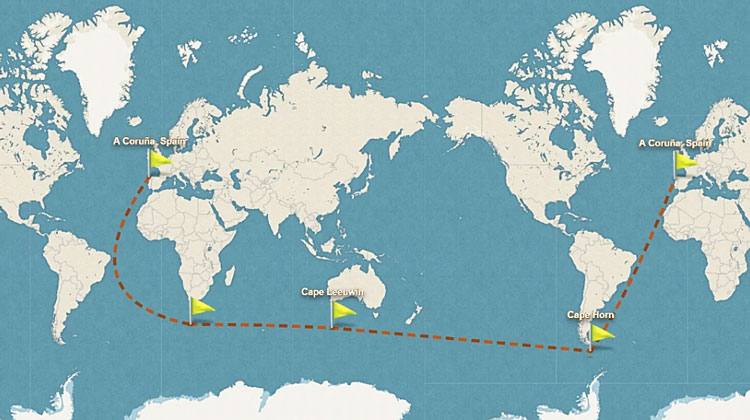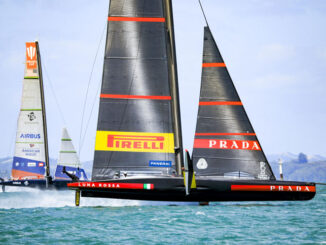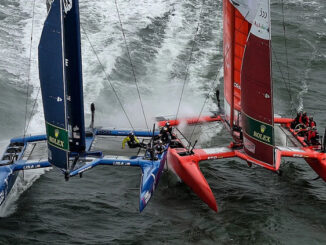
Participants to gain the bragging rights of becoming a member of an elite group of sailors
| New York, New York – 4/7/2022 – The Boating Chronicle – These days there is an explosion of sailing races taking place all around the world. However, there is one with a unique format—the Global Solo Challenge (GSC), a single-handed (meaning that there’s only one person on each boat), without assistance, non-stop, around the world sailing event.
In principle, the GSC bridges the gap between high-budget, professional events and the very human, yet common, dream of a single-handed circumnavigation. It is designed for sailors on a wide range of boats seeking the challenge of a competitive solo circumnavigation under the umbrella of an affordable, well-organized, and controlled event. To top it off, it’s a budget-friendly and environmentally-conscious race.
The race will start in A Coruña (La Coruña) in Spain in September 2023. The detailed information about the Global Solo Challenge 2023-24 can be found in the Notice of Event.
So far, 45 challengers, ages 32 to 69, have stepped forward and registered. The current 2023 elite group members are mostly men and 1 woman, Maxine Noury of France, who already has 22,000 miles of sailing under her belt.


There are 2 challengers from the US. They are Peter Bourke, who has 50,000 miles of sailing under his belt, as well as Colin Bastable, who also has sailed 50,000 miles.

Recently, we caught up with Marco Nannini, Event Director of GSC. Below is our conversation.
Q. When did the GSC get started?
The Global Solo Challenge was announced in December 2020 whilst the Vendée Globe was underway.
Q. How long will the race last?
We expect the fastest boats (Open 50s) to take around 120 days. The slower boats starting first, on the other hand, will set off 11 weeks before and could win by completing the event in just under 200 days, which is absolutely feasible for a good skipper on a good boat that would be assigned to the first start. These estimates are for a boat sailed well by a good skipper and without issues compromising boat speed. This inevitably means some boats may take as long as 250 days… we have set a time limit of 270 days to qualify as a finisher in the event.
Q. So far, you have two US participants, am I correct? They are Colin Bastable and Peter Bourke.
That’s right, however, we have received around 25 inquiries from US skippers out of a total of over 450 inquiries. Half of these are from skippers who already own a suitable boat to enter the event. We may still see further entries from the US, as some of them have written many times for clarifications or indicating they intend to enter but may be sourcing budget, need to find a boat, or need to see if personal circumstances allow them to commit to such a challenging project. Many things need to align in life to be in a position to undertake such an adventure.
Q. How many entrants are there as of the end of March?
We had a total of 45 entries as of the end of March. Not everyone will be a starter, but the level of interest raised by the event has been incredible.
Q. Is there a capability qualification process for participants or can anyone join in?
The organizers require that a skipper has completed a suitable single-handed passage of at least 2,000 miles on the boat they wish to sail in the event to be allowed to start. The qualifier does not need to be a race but must be pre-approved by the organizers to ensure it is not a summer light winds passage through the Med, for example, but a sufficiently testing navigation.
In partnership with the Royal Western Yacht Club of England, a new race has been envisaged in the spring of 2023, sailing from Plymouth around Iceland and back, which at that time of the year can be a really testing navigation and will take skippers out of the influence of the Gulf Stream and let them experience what sailing in really damp and cold weather is like.
There is no equivalent to the Gulf Stream in the Southern hemisphere and temperatures are much lower in the Roaring Forties and Screaming Fifties. Before Cape Horn, when dipping south to round the Cape, water temperature can be as low as 4 Celsius, just like on the Grand Banks of Newfoundland, in iceberg territory.
Q. How are security, safety, and health risks handled?
All boats are required to meet the stringent GSC Regulations which are based, with just a few adaptations, on the renowned World Sailing Offshore Special Regulations for Category Zero events where participants are expected to be self-sufficient in all weather conditions for prolonged periods of time and without the expectation of immediate or quick assistance in case of any type of problem, including where water temperature can be below 5° Celsius.
To have a fighting chance in case of damage to a boat in these conditions, it is best if the skipper can remain in the relative shelter of his or her boat with provisions and hopefully functioning satcoms, rather than being systematically forced to abandon ship for the liferaft, which in cold climates is far from the best place to be. For these reasons, even if a wide range and types of boats can be admitted in the event, all must be subdivided in 5 watertight compartments following a similar principle of military ships where, even for small vessels, build standards require that if one of the subdivisions becomes flooded the boat remains afloat, just lower on its waterline, giving the skipper the opportunity to assess the damage, perhaps even make repairs, and hopefully remain on the boat and set sail towards a safe port.
All skippers must carry survival suits if they are in contact with cold waters on the boat or when abandoning the vessel for the liferaft. All boats will carry at least four emergency beacons, two Emergency Position Indicating Radio Beacons (EPIRBs), one Personal Locator Beacon (PLB) and a Personal AIS Beacon, in addition to at least two Handheld Satellite Phones with spare batteries.
In case of an emergency, a lot depends on where this happens. In the Southern Ocean, there is very little if any commercial traffic and the closest chance of assistance or rescue may well be from another participant. It is also for this reason that the starts are staggered, letting the smaller boats leave first so that the fleet will compress rather than stretch as they progress towards the most remote areas of the Pacific and Cape Horn, with the larger boats behind the small ones. All skippers are required to have attended a “Survival at Sea” and heavy weather handling course in the 2 years preceding the event, as well as to have undertaken Medical Training, not just a First Aid course, but a much more advanced course that will give them more adequate knowledge of what to do in case of personal health issues.

Q. If there is a health or physical security emergency, how is it handled?
In case of an emergency, the organizers will liaise with the Search And Rescue (SAR) station in charge of the area of the world the boat is in. We will have to follow their instructions, including if it becomes necessary that other participants remain on stand-by or alter course towards the skipper in distress. It is an extremely delicate situation which must be coordinated centrally and unequivocally by the SAR professionals as there is, inevitably, only so much we can do remotely other than supply all significant information and assistance to those managing the emergency.
Q. Are potential pirates an issue? If so, how are they avoided? What are the areas to watch out for?
I would say not at present. The danger zones of the world are not en route for the participants in the Global Solo Challenge. These include areas on the approach to the Red Sea, some areas in the proximity of the north coast of South America where boats may be hijacked to be then used to transport drugs, or areas such as the Malacca strait and proximity. In the past, there have been some incidents near the coast of Mauritania, Africa, which is en route.
When I sailed by the coast of Mauritania during the Global Ocean Race 2011/2012, out of nowhere and quite far off the coast, we saw in the distance a small boat approaching us at full speed. It was unusual that a boat of that size would be some 40-50 miles offshore, so we were tense. As the boat approached the four men on the boat gave us the friendliest of smiles and waved us good luck, they were simply curious fishermen. This was 10 years ago and we had been warned about a marginal risk at the time, but I am not aware of any recent activity anywhere en route. We will check the situation in 2023 and alert the skippers if we become aware of any change.
Q. Will organizers have training sessions?
The skippers that have entered are scattered from the US to Europe to Australia; it would be difficult to organize any in-presence training.
I personally ran an offshore sailing and racing training center for 5 years between 2013 and 2018 and we are working on writing many useful articles on various relevant topics, from weather routing to use of satcoms, to sleep management and so on, so that hopefully will encourage all participants to look into all these aspects in depth.
We are also considering organizing some online sessions with Q&As and on topics which may not be easily covered by articles. The reality is that preparing for a circumnavigation single-handed not only lends itself to finding many solutions to each problem, especially as the boats are of different sizes and types, but this is a navigation that requires just such an all encompassing variety of skills that the best lessons are learnt by sailing as many miles as possible before the event—there is no substitute for this.
There is only so much a course or a written article can teach you compared to real life situations and experience. Other than this, we are always available to answer any questions a skipper may have including any suggestion or proposed solution to any problem or aspect of the regulations.
There is a very important principle that must never be forgotten, it is the skipper who is wholly and solely responsible for ensuring his boat is suitably prepared and that they are capable and fit to undertake the event. What the regulations do is provide a framework that enhances, but will never be able to “guarantee” protection from the many risks each participant will face. It is not for everyone.
Q. Once it starts, will you have daily or on-demand contact with racers?
he event website has been developed to allow for skippers to autonomously and independently send updates to the website which can include text, photos, video or audio files.
Unlike other events, these are not sent to the organizers who then pick and choose what to publish, instead the website hosts each skipper’s blog. We will then write daily or periodical digests, analysis, articles, press releases, put together videos etc, but each skipper will have a chance to have his/her voice heard and not just at the discretion of the organizers.
I sailed in many races where my blog was on my website and despite sending my updates to the race HQ, none of my updates would be picked up, especially in the big French races, as I was writing in English and they would concentrate on the easier-to-process French updates from French-speaking skippers. Also they would always favor updates from the boats leading the race and if you were not in front you’d be forgotten. I don’t want skippers in the Global Solo Challenge to ever feel they are less important than any other entry. In fact, the innovative format of the event with starts staggered by boat performance characteristics makes it so that there is absolutely no way to pick a favorite type of boat for the overall win, and each skipper stands a chance.
Smaller boats will be in front at the start, in a re-enactment of the tale of the tortoise and the hare, which I think will be fascinating to follow and will never make a small boat or lower budget entry any less interesting to follow. I think the human side of each entry will really come through as this is the ultimate adventure for all participants.
Q. Will there be any near-real-time live video YouTube posts from racers?
This is not the Vendée Globe, skippers won’t all have the budget to allow for such data hungry communications. In the Vendée, skippers buy a package negotiated by the organizers to be used with their expensive broadband satellite equipment; it all comes to a lot of money. We have an American partner Satcom company for the event, Global Range Services, and we have worked on putting together a package that is budget friendly for the needs of a typical Global Solo Challenge participant. This will cost a fraction of what a Vendée Globe boat spends for their 3 odd months at sea. Boats in our event will be at sea for much longer, which would only make the overall cost higher, and probably only a few will buy broadband satellite equipment.
The minimum package we put together will provide the typical skipper with two handheld Satphones required by the regulations and to be used in emergencies plus a satellite wi-fi hot-spot for every day use which will provide them with 150 voice minutes a month and unlimited data for emails and download of weather files. The data is unlimited but the bandwidth is small and very slow and would not allow for streaming of videos like on the broadband systems you have on Vendée Globe’s IMOCA 60s. Still, skippers, even with this minimal equipment, will be able to send short lower resolution clips, text and photos and without having to worry about the cost as all the data transmission, however slow, is included in the package. I think this is a good compromise and will provide plenty of audio-visual as well as text material to bring the event to life. We will also have satellite equipment and airtime provided by our partner to call and interview skippers and of course for calls in any emergency situations.
Q. Are we going to be able to follow the race through something like a YB Tracking application? (See this article)
Yes, every boat will be supplied with two YB Trackers, a primary unit and a backup unit, and the website will display online cartography of all boats together with weather information and will be updated typically every 4 hours.
Q. It is not hard to see how all participating challengers who finish the race can be considered a winner. However, when all is said and done, what does the winner of the official GSC race win?
There are cash prizes for the top 3 finishers, as well as trophies. There will probably be other trophies but these aspects will be communicated at a later date.
Cover photo: Marco Nannini rounding Cape Horn during the Global Ocean Race 2011/2012. Photo courtesy of GSC.


